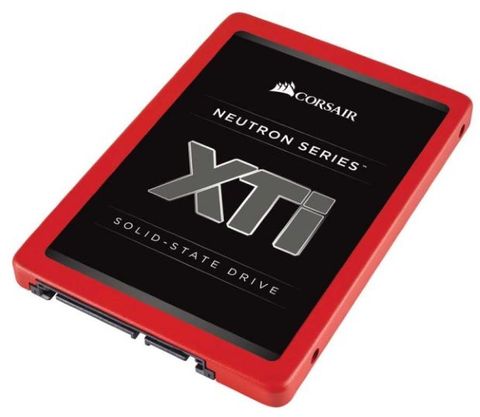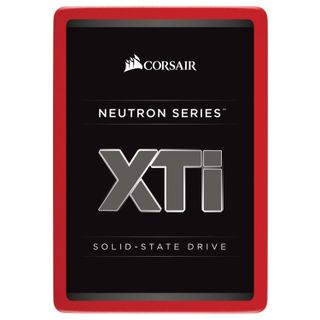Early Verdict
Until Corsair and Phison work out the low random read performance the Neutron XTI will remain a mainstream SSD that will not sell with a premium price. The SSD delivers excellent heavy workload performance, but normal consumer workloads prove to be problematic.
Pros
- +
Excellent steady-state performance
- +
Class-leading sequential performance under heavy workloads
- +
Excellent random write performance consistency under heavy workloads
- +
Low latency under heavy workloads
Cons
- -
Poor random read performance
- -
Poor random mixed workload performance
- -
Low consumer workload application performance
- -
Premium pricing
- -
Shallow accessory package
Why you can trust Tom's Hardware
Specifications And Features
Corsair returns to the premium SSD market with the new Neutron XTi, which doubles the SSD's onboard DRAM in a bid to improve performance and consistency. The extra DRAM also allows Corsair to increase capacity up to 2TB and deliver up to 560/540 MB/s of sequential read/write speed and 100,000/90,000 random read/write IOPS.
The Corsair Neutron XTI is an interesting product release due to the lack of new high-performance SATA 6Gb/s SSDs on the market. The industry saturated the throughput limits of the SATA 6GB/s interface long ago, so the latest advances come in the form of increased random performance and consistency. The Samsung 850 Pro and SanDisk Extreme Pro have dominated the high-performance realm for two years without any real competition, and only a few products have even attempted to target the segment. Unfortunately, the latest contenders failed to meet the high bar set by the Samsung and SanDisk SSDs.
Corsair takes an interesting approach to boost the Neutron XTi's performance. Several controller manufacturers have DRAMless products on the market, or coming to market, in an attempt to offer the lowest possible price point. For years, we've known that increasing (or decreasing) the amount of DRAM could affect performance, primarily due to the impact that it has on internal SSD management functions. The XTi is the first product to move the needle the other direction and add DRAM to increase performance.
Corsair tells us the Neutron XTI increases performance consistency as a direct result of doubling the DDR3 DRAM over Phison's reference S10 design. The new double-DRAM design also addresses low queue depth random performance, which is the sole area where the S10 controller trails other high-performance SSDs.
Technical Specifications
Three of the four new Neutron XTi SSDs will ship this month, but the 2 TB SSD will not ship until later this year when Corsair finalizes the firmware, so those with a large enough budget will have to wait. All four drives use the same basic configuration with a quad-core Phison PS3110-S10 controller, which we covered in a dedicated and detailed editorial, at the heart of each drive. The three largest drives leverage all 8 channels, but the 240 GB drive operates in 4-channel mode, which reduces performance and power consumption. Corsair selected Toshiba's 15nm MLC for this series after finding that it delivers higher small-block random performance compared to 16nm IMFT MLC flash.
The Phison S10 controller delivers exceptional sequential performance, even with 3-bit per cell (TLC) flash, but it never actually lived up to initial expectations regarding small-block random performance. To address this issue, Corsair doubled the amount of DRAM over the aging Neutron XT products, but on paper, the two SSDs share the same performance specifications. These workloads fall outside of the specification sheet, but they are where users can actually experience an increase in application performance.
Corsair and other SSD manufacturers spec products at high queue depths, but modern SSDs often saturate the SATA interface when tested under heavy load. End users should be more concerned with low queue depth performance because during normal workloads the system rarely exceeds QD4. Even during intense multitasking, it's difficult to reach anything over QD8.
Pricing, Warranty And Accessories
As mentioned, only three of the four Neutron XTi drives are available at launch. The large 2TB SSD will ship later this year, and pricing information will come at that time. The Neutron XTi 240 GB carries an MSRP of $94.99, the 480 GB retails for $179.99 and the 960 GB weighs in at $329.99.
All Neutron XTI SSDs include a 5-year warranty that Corsair limited with a total bytes written (TBW) clause. The TBW rating varies based upon capacity, as listed in the table. The XTi series works with Corsair's SSD Toolbox software, which allows users to manage and control various aspects of the SSD, such as overprovisioning and secure erase operations. It also provides SMART monitoring features.
A Closer Look



Crucial hasn't changed product packaging much since the Force 3 SSDs that arrived during the SandForce era. The accessory package has declined over the years, though. The Neutron XTI ships with a 7mm to 9.5mm adapter bracket and a paper pamphlet that outlines the warranty terms.
Retail shoppers can easily find performance specifications on the front of the package, and a brief description on the back. The product's serial number is visible through a cutout on the back of the package. We're testing serial numbers 1 (960 GB) and 2 (480 GB).




Corsair introduced the red color scheme on the Neutron XT more than a year ago. The red color signifies flagship status in the company's SSD product line. Corsair uses a good, better, and best strategy for its SSD line, with the Force LE in the entry-level position and the new Neutron XTi at the high-end. The Force LS and LX sit in the middle for now, but we expect Corsair to release new mainstream SSDs soon that will replace both aging products.




Outside of the additional DRAM and flash capacity, the two drives are identical. We hope to test the 4-channel Neutron XTi 240 GB soon to see if its performance warrants inclusion in our monthly Best SSDs List.
MORE: Best SSDs
MORE: How We Test HDDs And SSDs
MORE: All Storage Content

🔥 Black Friday deal: 1TB WD Black C50 SSD Xbox Series X|S expansion card down to $99, its lowest-ever price

Google may be forced to sell its Chrome browser due to monopoly complaints — potential $20 billion sale if approved by a judge

Two undersea internet cables connecting Finland and Sweden to Europe have been cut — EU leaders suspect sabotage
-
Kimonajane Too expensive still. Better having a smaller SSD for programs and using big platter drives for storage. I don't know why the average Joe needs so much storage anyway. I guess if you digitally download movies or take many high resolution pictures. There is where cheap platter drives still win. Use one always for backup too.Reply -
Sakkura High-end SATA SSDs have been a little pointless (for consumer use) for a long time, but it's only getting worse as PCIe storage proliferates. Right now, 99.9% of people should either get an affordable mainstream/budget SATA SSD, or if they really need the speed, go for an M.2 PCIe (or U.2 or PCIe AIC) SSD. If you're gonna pay for a premium product, you might as well go for what's actually considerably faster across the board, rather than this kind of half measure.Reply -
chalabam Most drives are now bottlenecked by SATA.Reply
And because a lot of people cannot change the motherboard to get no SATA drives, SATA drives should come with multiple parallel SATA connectors, and a software driver capable of using them to extract more speed out of the SATA interface. -
chalabam Most drives are now bottlenecked by SATA.Reply
And because a lot of people cannot change the motherboard to get M-2 or fancier, SATA drives should come with multiple parallel SATA connectors, and a software driver capable of using them to extract more speed out of the SATA interface. -
Sakkura Reply18326906 said:Most drives are now bottlenecked by SATA.
And because a lot of people cannot change the motherboard to get M-2 or fancier, SATA drives should come with multiple parallel SATA connectors, and a software driver capable of using them to extract more speed out of the SATA interface.
No point, simpler to just run them in RAID0 if you need more speed. -
deus You'll be interested to kno none of the charts display in FF 47.0.1 and the same applies to the review of the SK hynix .Reply
Charts do show in IE 11.
Nice.
Lets earn money anyway we can, eh ?

